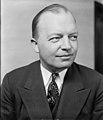| 1944 presidential election | |
  Nominees Dewey and Bricker | |
| Convention | |
|---|---|
| Date(s) | June 26–28, 1944 |
| City | Chicago, Illinois |
| Venue | Chicago Stadium |
| Candidates | |
| Presidential nominee | Thomas E. Dewey of New York |
| Vice-presidential nominee | John W. Bricker of Ohio |
The 1944 Republican National Convention was held in Chicago, Illinois, from June 26 to 28, 1944. It nominated Governor Thomas E. Dewey of New York for president and Governor John Bricker of Ohio for vice president.






